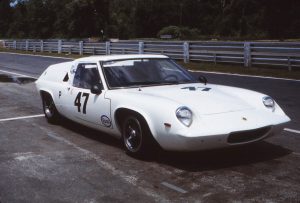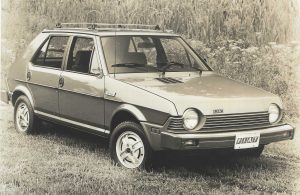History/driving impressions originally published in AutoWeek September 16, 1985
Tim Ritter was right. The interior does not suffer gladly the intrusion of large adults. It’s large adults who suffer. Those of us with more modest proportions are merely constrained to one position. There is no room to shift about, to spread out. Leaning forward – to gain a little angle on a blind corner, for example – one’s forehead will strike the headliner. So one must remain in the semi-reclined position. It requires the cool nerve of a spelunker and a total absence of claustrophobic tendencies, but those willing to endure close quarters the Abarth 1300/124 Scorpione SS will happily reward.
Consider this: The Scorpione SS could pull over 0.80G on the skid pad in the late ‘60s on contemporary tires – better than any Lotus or Porsche. It came with a special Abarth-modified 1300cc Fiat 124 engine producing 100 HP (DIN), in a package weighing only about 1,600 pounds. There are Girling disc brakes at all four wheels and the whole package is wrapped in a vest pocket capsule that’s as small as it is slippery.
This is a driver’s car, built with all the enthusiasm of any Abarth product and equally up to the challenge of cars with double the displacement. That’s why Tim Ritter, purveyor of small and arcane exotica (M.R.Classics Inc.of Belleville, Illinois), sees this, of all the tempting morsels that pass his way, as a keeper.
It is the best of its ilk – and its ilk are legion – sitting as it does at the top of a couple of evolutionary chains. It’s Carlo Abarth’s last attempt to produce a GT car, a road car. And it’s the most potent of all the permutations of a series beginning with a car built for the 1967 Turin auto show.
That car was designed around the engine/transmission of the front-wheel-drive Autobianchi Primula, a Fiat design, though with the drive unit moved to the rear. The body was drawn by Pio Manzu of the Fiat Styling Center, and the car, to be known by its prototype designation “G-31,” would be the forerunner of the Fiat X1/9.
But Fiat, for all’s eventual interest in the transverse mid-ship engine concept, was no longer interested in the body that originally housed it. (It should be noted that any history of Abarth will contain a lot of “probably’s,” as in “the ‘facts’ presented here are ‘probably’ true.” They are the best prevailing truth. But they may not be completely true. For one thing, Carlos Abarth is now dead. And for another, if he were alive, he probably wouldn’t provide much anyway. Abarth was always short on providing information, and was practically averse to releasing production numbers. Very Italian, even if he was really Austrian.)
The body design somehow ended up in the hands of one Francis Lombardi, whose Turin shop was better known for producing airframes than automobiles. It was Lombardi’s idea to produce the car, which had been such a hit at the Turin show, except with a Fiat 850 engine and transmission installed in traditional Fiat 850 manner, i.e., longitudinally in the rear. He optimistically renamed it the Lombardi Grand Prix.
Lombardi also built the body for a customer, OTAS, which equipped it with a 1000cc Giannini-modified Fiat 850 engine and marketed it as the OTAS Grand Prix. A few were imported by Californian John Rich, but these had smog-law busting sub-50 CID engines that, even in the lightweight coupe, were slower than a postman delivering a check.
Abarth saw the Lombardi/OTAS is a Good Thing, lacking only a proper engine and perhaps a little suspension fiddling a la Abarth, and somehow managed to become involved in producing an Abarth version of the car. There were several versions of the Abarth product. The first was a slightly modified Fiat 903cc 850 engine, capable of 100 mph from 52 HP (DIN). Then came the Scorpione. (Or a Scorpione. Abarth, a Scorpio, use the scorpion in his logo, and very appropriately for an enthusiast of rear-engined cars, and several cars were known as Scorpiones.)
This Scorpione, the 1300/124 OT, came with the 1197cc Fiat 124 engine bored out to 1.3 liters, hence the designation. The engine, a pushrod iron block, aluminum head design, had been used previously in the Fiat 850 Coupe-based Fiat Abarth 1300s/124 OT. Carburetion was by a single sidedraft twin-throat Weber, and new pistons gave a compression ratio of 10.5:1. The engine – exhaust, cam and head – was otherwise stock and, with rotation reversed to accommodate the Fiat 850 transaxle, produced 88 BHP (SAE) at 6000 RPM. As with the modified Fiat coupe, a front radiator was added (eliminating overheating, an OTAS bugaboo). The Scorpione with this engine, combined with the stock Fiat 850 suspension, was the “S” version.
The hot version, the SS (or S/S, equally acceptable), received a double A-arm front suspension it was right out of Abarth’s modify-your-Fiat wish book. It replaced the transverse leaf spring that formed the lower link of the Fiat suspension with a rigid transverse member, to which was bolted the new lower A – arms. The SS package also included four-wheel Girling disc brakes, replacing the Fiat 850 disk/drum system of the lesser models. The rear suspension was reworked, with special half-shafts with dual CV joints. Very few SS models were sold with optional dual twin-throat Webers.
It was a simple package, and very un-Abarth like in profile, being wedgy rather than bulbous, and steel-bodied rather than aluminum. But like almost all Abarth’s, it was small. A Lotus Europa overwhelms it. At 80.5 inches, the Abarth’s wheelbase is a foot shorter than a Lotus’, the Abarth is six inches narrower and over a foot shorter overall. Both cars are 42 inches tall…or short.
The Scorpione is actually better looking than the Europa, however, thanks to the retracting headlights that provide a more pleasing fender line and the sail panels with an interesting concavity and a natural slope is more satisfying of either the bread van or pickup truck Europa. That the car doesn’t look as small in photographs as it really is shows how well proportions have been worked out. To get some idea how small the car is, however, examine the front fender opening, which curves almost all the way to the top of the fender. Then notice that the tire fills the fender opening and then consider that it’s a 13-inch tire.
The engine would seem to have poor maintenance access, what with the small lid on the rear deck. However, loosening six screws allows the removal of the entire rear panel, making the car very easy to work on, much easier than the Europa.
But unlike the Europa, very few Scorpiones were made and only a handful were U.S. models, one of which is Ritter’s. The cars built for America can be distinguished by the twin windshield wipers (the Euro cars had a cyclops wiper), DOT sidemarker lights, and an aluminum rear bumper that offered as much protection as a peashooter in a gang fight.
The tightening noose of federal smog and safety laws would have spelled eventual doom for cars like the Scorpione, but Fiat’s acquisition of Abarth spiked the project before it could gather much momentum at all. A final effort to market the car as a Lombardi came to naught when Francis Lombardi’s benefactor, a Cypriot with a shady reputation, was run down, a victim of vehicular homicide.
Which brings us full circle, with Lombardi holding a chassis Fiat didn’t want. More’s the pity and more’s the reason to sample the Scorpione SS once more.
Climb in and assume the semi-reclining position. Find the pedals skewed to the right, clearing the wheel well that intrudes on the left. Note that the instruments, with large tach and speedo, are on a central pod, with no instruments directly in front of the driver. There isn’t room. The steering wheel, at arms length, is inches away from the windshield. The gearshift is straight from the Fiat 850, though maybe slightly shorter, but just as effective. Which is to say that it feels bad, mushy and without the crispness of a gearbox-mounted shifter, but it works well, never losing a shift. Acceleration is brisk and cornering is precise and it’s everything a small sports car should be. If compromise exists, it’s not in performance but in comfort.
Researchers tell us the tall people have the best jobs, make the most money, and get more respect than those of us of normal height. All that may be true. But one thing their height won’t get them is into an Abarth Scorpione SS. And considering what a neat little car it is, that’s almost revenge for the rest of us.
It says something about that author that if I had a large garage with room for a lot of cars, this one be in one of the spots.How about you?














Due to comments around a recent OTAS selling cheaply on B.A.T. , I have been directed to you blog about the Lombardi-Scorpion, Abarth and SS. Very nicely stated regarding all impressions. Thank You. Mine is OTAS #75 that I purchased in the mid 80’s, and have been collecting parts and building the car for many years. PBS reverse rotation bell housing and kit, with coil over front shocks, Abarth taller ring and pinion, Compo-motive 3 piece wheels that make it even lower, Fiat X19 front radiator, Solex side draft- and too many other collected parts from afar to mention. At 6’2″ I fit fine, maybe because there is a well cut out in the pan to accommodate an extra inch or so. A keeper, because my name is not Carlo Abarth, and my work will never be compensated in perceived value. I am an Italian car parts restoration guru, dba ODD Partx Xxxxxxxxxxx, and invite conversations on all Italian cars, There is little that we have not repaired, find, or fabricated. Call me.